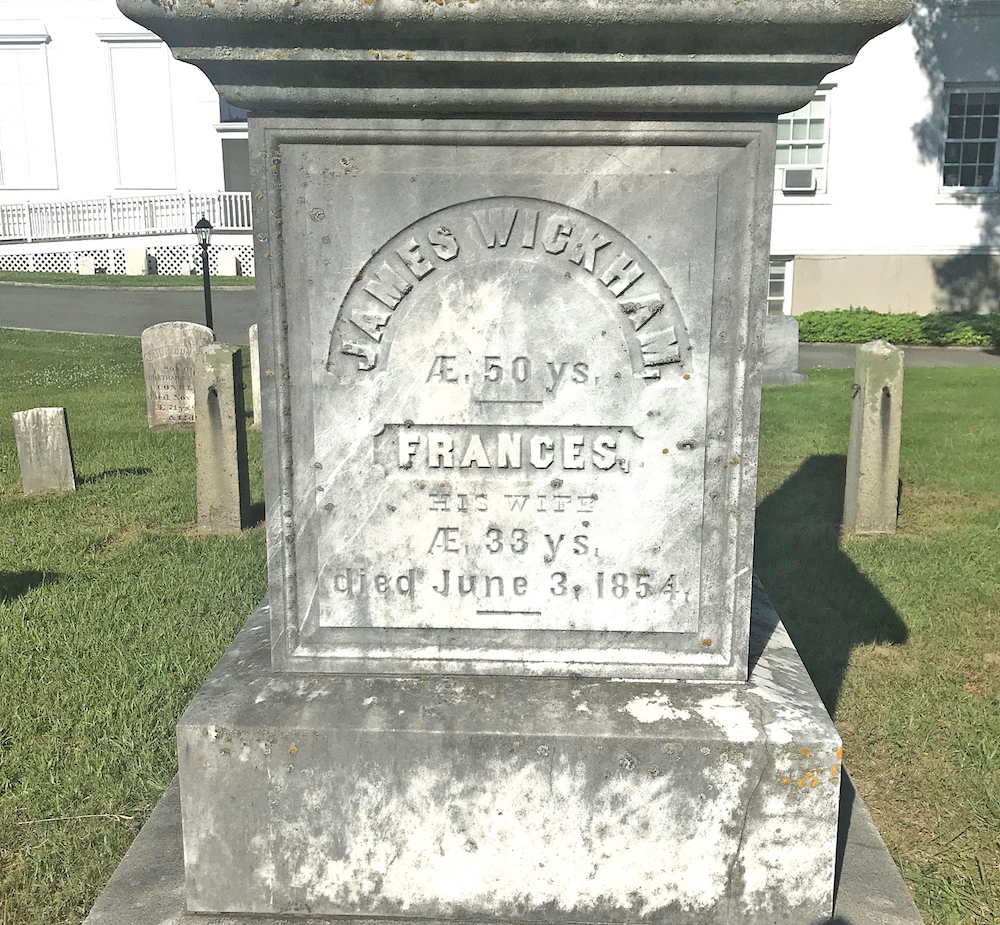North Fork History Project: The Wickham murders part two; a field hand exacts revenge


He had spent the days since May 30, when he was fired by James Wickham, seething with resentment. He had already visited the Cutchogue farm of James Wickham’s father, William Wickham Sr., to seek help in getting his job back. Unsuccessful, Mr. Behan went the following day back to James Wickham’s farm to pick up his belongings and from there went to Greenport.
There, he moved into a boarding house run by the Connor family and found a job in the brickyards at Hashamomuck. Late on the evening of June 2, three days after his firing, Mr. Behan left the boarding house and walked the rail line from Greenport back to Cutchogue, a man on a mission.
It was around midnight when he arrived at the Wickham farmhouse. The house was pitch black. On the east side of the house was the kitchen and, above that, the sleeping quarters of Stephen Winston, a teenaged employee of the family. Mr. Behan knew where Stephen slept, and also knew there was a dog in the house that might alert the Wickhams to his presence.
In the barn, which Mr. Behan knew well from his work as a field hand, he retrieved a post ax — an instrument often called a mortise ax, with a long, narrow head used to make fine cuts in timber.
Then he approached the house. The worst recorded crime in Southold’s history — at least since English settlement more than 200 years before — was about to take place.
That spring, as Geoffrey K. Fleming and Amy K. Folk write in their book “Murder on Long Island,” the routines on a large North Fork farm were pretty consistent: “Following a fine meal, the men and women of the house retired to their separate parlors to read and discuss the day’s news before turning in for the evening.
“Last to go to bed were the housemaids, who finished cleaning and extinguishing candles, lamps and fires before they went to their rooms for the evening. It should have ended like any other day, but unfortunately, it wouldn’t. For the Wickhams and Ellen Holland, Mr. Behan’s departure from the farm must have seemed to be the conclusion of their problems, but in fact, it was only the beginning,” they wrote.
Mr. Fleming and Ms. Folk provide the most likely route into the house: through an unlocked kitchen window. What about the dog, which slept in the kitchen? No problem. He knew Mr. Behan from working on the farm and living in the house.
Once inside, Mr. Behan climbed the servants’ stairs to the second-floor bedroom where Stephen slept. Just at the start of his teen years, Stephen, who was black, is one of those characters about whom history does not tell a lot. The authors do their best to give him a biography: Born in New York City, he was one of seven children of a Virginia-born woman named Susan.
Once he reached Stephen, Mr. Behan savagely attacked him with the ax, striking him “several times on the head, leaving him incapacitated and unable to move. Blood splattered everywhere and traveled down the handle of the axe all over Behan’s hands,” they wrote.
He then opened the door that separated the kitchen wing from the main part of the house. As the door opened, Mr. Behan was confronted by Frances Wickham, who told him to take what he wanted and leave the house.
Mr. Wickham then appeared in the hallway. Mr. Behan pushed both Wickhams back into their bedroom, where he struck Mr. Wickham in the head with the ax. Court depositions taken in 1854 show that the attack took place in the center bedroom, not the corner bedroom pictured in the June 21 edition of The Suffolk Times and the Riverhead-News Review.

“Nicholas, don’t kill him!” Mrs. Wickham screamed. “Don’t kill him! Take what you want in the house, but don’t kill him!”
Mr. Behan struck Mr. Wickham repeatedly with the axe. Mrs. Wickham, in full panic, tried to escape through a window, “but Behan grabbed her and dragged her across the floor to keep her from causing any further alarm. He then took the bloodied axe and stuck her twice in the head. So hard were the blows that her skull was shattered, causing blood and brain matter to be spewed around the room.”
In the attic directly above the bedrooms, the two house servants — Ellen Holland and Catherine Dowd — heard the screams. No doubt Ellen knew Mr. Behan had returned to exact revenge for his dismissal, which was precipitated by his aggressive attempts to date her, the theft of money from her personal trunk and his pushing Ms. Wickham against a wall.
First, Catherine fled the attic via a window that let her drop down to the roof over the kitchen wing. From there she clambered down to the roof of the milk house, then to the ground. In the darkness, she fled up the lane to Main Road, where she banged on the door of William Betts’ home, screaming for help.
Realizing Mr. Behan would come for her next, Ellen fled via the same route.
After attacking the Wickhams, Mr. Behan climbed the staircase to the attic, only to find both young women were gone. He then fled out a second-floor bedroom window, lowering himself to the ground, leaving the bloody ax behind on the ground.
Five Cutchogue men, alerted by Catherine and Ellen, ran to the Wickham house. They broke down a door into the kitchen, lit a lamp and climbed the main staircase to the second floor. There, they found the Wickhams — James was still alive, but “Mrs. Wickham’s skull had been penetrated by vicious blows that caused a large portion of brain matter to be thrown upon the floor.”
Above the kitchen, they found Stephen, “dreadfully injured in the head…,” with one ear sheared off and a fractured skull, Ms. Folk and Mr. Fleming write.
Mrs. Wickham was pronounced dead around 2 a.m.; Mr. Wickham lingered a bit longer before dying.
Meanwhile, as word of the horrific crime spread in Cutchogue, houses began to light up like fireflies in the night air — one house, then another, all along Main Road. No one knew if the killer was still about.
Mr. Behan ran up to the train depot and then, following the tracks, east to Greenport. A mob of North Fork men, armed with what guns they had, began to search for him.
The next day, June 3, after nearly being seized in the home of John Thompson, Mr. Behan headed west, toward Hashamomuck Pond, avoiding groups of armed men looking for him.
Sunday, June 4: more searching, to no avail.
Monday, June 5: Mr. Behan remained hidden in a swampy area of what was then called Hermitage, which is present day Peconic. Two men, John Jones and John Jacobs, according to Mr. Fleming and Ms. Folk, found Mr. Behan in a foot of water, a self-inflicted cut across his throat.
On the day Mr. Behan was found, hundreds of people, many from far away, came to Cutchogue for the Wickhams’ funeral, which was held under a big willow tree behind the farmhouse. The Long Island Rail Road ran a special train to bring people out for the event.
Afterward, the funeral procession, estimated at two miles in length, followed the caskets to the Presbyterian church in Mattituck, where the couple was interred in a Wickham family plot.
In October, Mr. Behan went on trial in the county courthouse in Riverhead. Because James Wickham’s brother William Wickham Jr. was the district attorney of Suffolk County, he could not try the case. Another prosecutor was named: Ogden Hoffman, the attorney general of New York State. Riverhead attorney Spicer Dayton was appointed to represent Mr. Behan.
He was convicted.
Early on the afternoon of Dec. 15, 1854, before a crowd estimated at 3,000, Mr. Behan was hanged in the yard of the Suffolk County jail in Riverhead. He was buried in an unmarked grave.
What became of Ellen Holland?
She married a fellow Irish immigrant, Daniel Haggerty, and they lived as a couple with their three daughters, Rose, Mary and Frances, on a farm on Oregon Road in Cutchogue. Was Frances named after Frances Wickham?
Mr. Haggerty died in 1894, his name memorialized in a stained-glass window in the now shuttered Sacred Heart Church in Cutchogue. Ellen Haggerty died in 1901. While her death was written up in local newspapers, none mentioned her role in the Wickham murders.
Her gravestone at Sacred Heart Cemetery on Depot Lane in Cutchogue bears just a name and date. A poor excuse for a biography of a famous woman.









